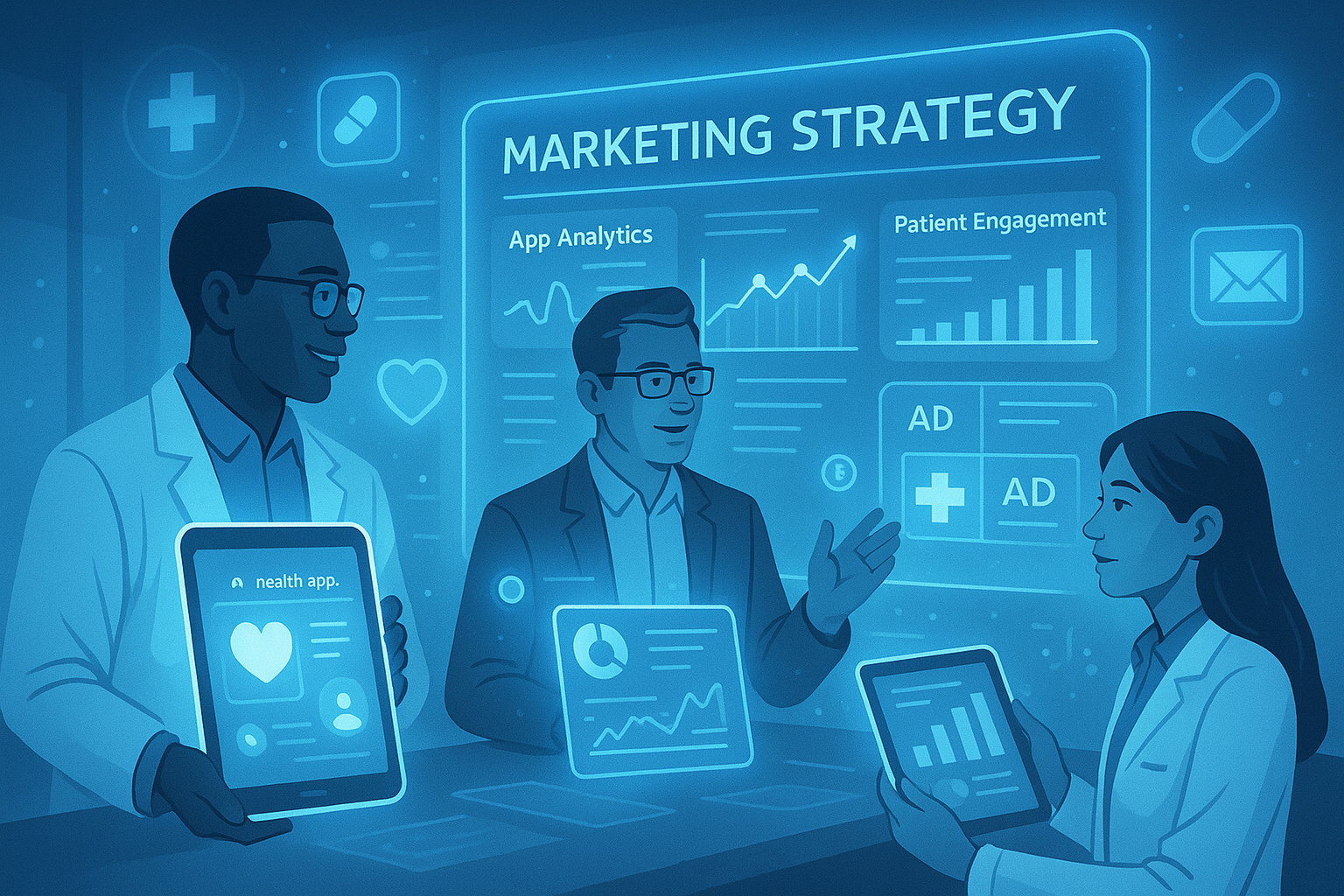Your hospital’s marketing team launches a comprehensive campaign promoting your new orthopedic center. Billboards go up across the city. Digital ads blanket social media. Direct mail pieces flood mailboxes. The budget: $500,000. Three months later, you’ve generated 47 new patient appointments. Cost per acquisition: over $10,000. The campaign technically succeeded, but the ROI is dismal.
Meanwhile, across town, a competing health system takes a different approach. They analyze their patient data and discover that 68% of their orthopedic patients are women aged 55-70 with specific insurance plans, living in particular ZIP codes, who previously visited for primary care. They’ve identified that these patients typically search online for “knee pain relief” and “hip replacement recovery” before booking appointments. Armed with these insights, they create targeted campaigns reaching this precise audience with personalized messaging at optimal times through preferred channels. Their investment: $200,000. Result: 340 new patients. Cost per acquisition: $588.
The difference? Data-driven marketing versus guesswork.
Patient data is healthcare marketing’s most underutilized asset. Health systems sit on treasure troves of information—demographic data, clinical histories, utilization patterns, engagement behaviors, satisfaction scores, and more. Yet most organizations barely scratch the surface of what this data can reveal about how to attract, engage, and retain patients more effectively.
According to McKinsey research, healthcare organizations that leverage patient data effectively for marketing achieve 15-20% higher ROI on marketing spend and 25-30% better patient retention compared to those relying on intuition and broad demographic targeting.
This comprehensive guide explores how to harness the power of patient data to transform marketing performance—from building the foundation through data infrastructure to executing sophisticated segmentation, personalization, and predictive analytics that drive measurable results.
Understanding the Patient Data Landscape
Before leveraging data, understand what’s available and how it can be used.
Types of Patient Data
Demographic data:
Age, gender, location (address, ZIP code)
Household composition and income (appended)
Language preference
Insurance type and coverage
Employment status (when available)
Clinical data:
Diagnoses and conditions
Procedures and treatments received
Medications prescribed
Allergies and health risks
Care gaps and preventive care needs
Chronic disease status
Utilization data:
Visit frequency and recency
Service lines used
Providers seen
Facility locations visited
Emergency department usage
Hospital admissions and readmissions
Engagement data:
Website visits and page views
Patient portal logins and usage
Email opens and clicks
Mobile app interactions
Call center contacts
Social media engagement
Satisfaction data:
HCAHPS scores
Press Ganey ratings
Patient surveys and feedback
Online reviews and ratings
Net Promoter Scores (NPS)
Complaint and compliment data
Financial data:
Lifetime value calculations
Payment history and patterns
Outstanding balances
Financial assistance utilization
Insurance reimbursement rates
The Privacy and Compliance Framework
Patient data use for marketing must navigate complex regulations:
HIPAA regulations:
Marketing communications require authorization (written permission) if they include Protected Health Information (PHI)
Exception: Treatment communications don’t require authorization (appointment reminders, follow-up care, case management)
De-identified data: Can be used for marketing without authorization if properly de-identified per HIPAA standards
Limited data sets: Can be used with data use agreement
Business associate agreements: Required for vendors handling PHI
State privacy laws:
California Consumer Privacy Act (CCPA)
Virginia Consumer Data Protection Act (VCDPA)
Other state-specific regulations
May require explicit opt-in for certain data uses
Consent management:
Clear opt-in/opt-out mechanisms
Granular choices (email vs. text vs. phone)
Easy preference updates
Documented consent tracking
Ethical considerations beyond compliance:
Use data in patients’ best interests
Transparent about data collection and use
Respect patient preferences and privacy
Avoid exploitation of vulnerable populations
Maintain data security
According to the U.S. Department of Health & Human Services, the key question for HIPAA compliance is whether the communication encourages purchase or use of a product/service—if yes, it’s marketing requiring authorization unless it falls under an exception.
Data Quality: The Foundation
Data-driven marketing is only as good as data quality:
Common data quality issues:
Duplicate records (same patient, multiple IDs)
Incomplete data (missing contact information)
Inaccurate data (wrong phone numbers, outdated addresses)
Inconsistent data (name variations, formatting differences)
Outdated data (patients moved, changed insurance)
Data quality improvement:
Regular cleansing: Quarterly or semi-annual data hygiene
Deduplication: Identify and merge duplicate records
Validation: Verify contact information periodically
Standardization: Consistent formats and conventions
Enrichment: Append external data (household data, propensity scores)
Update mechanisms: Easy ways for patients to update information
Data quality metrics:
Completeness rate (percentage of required fields populated)
Accuracy rate (verified correct information)
Duplication rate (percentage of duplicate records)
Deliverability rate (emails/mail reaching recipients)
Update recency (how current is data)
Building the Data Infrastructure
Effective data use requires integrated technology and processes.
Essential Technology Components
Electronic Medical Record (EMR/EHR):
Source of truth for clinical and utilization data
Examples: Epic, Cerner, Meditech, Allscripts
Customer Relationship Management (CRM):
Central repository for patient interactions and marketing data
Integration with EMR for clinical context
Examples: Salesforce Health Cloud, Microsoft Dynamics 365, HubSpot
Marketing Automation Platform (MAP):
Executes targeted campaigns across channels
Tracks engagement and attribution
Examples: Marketo, Pardot, Adobe Campaign, HubSpot
Data Warehouse/Analytics Platform:
Aggregates data from multiple sources
Enables complex analysis and reporting
Examples: Snowflake, Google BigQuery, Amazon Redshift, Azure Synapse
Business Intelligence (BI) Tools:
Visualizes data and creates dashboards
Self-service analytics for marketers
Examples: Tableau, Power BI, Looker, Qlik
Customer Data Platform (CDP):
Unifies patient data from all sources
Creates single patient view
Enables real-time personalization
Examples: Segment, Tealium, Adobe Real-Time CDP
Data Integration: Creating a Single Patient View
The biggest challenge is integrating data silos:
Common silos:
EMR separate from marketing database
Website analytics not connected to CRM
Call center data in standalone system
Patient portal separate from email marketing
Satisfaction surveys disconnected from patient records
Integration approaches:
Point-to-point integration: Direct connections between systems
Pros: Fastest to implement
Cons: Becomes complex as systems multiply
Integration platform as a service (iPaaS): Middleware connecting systems
Examples: MuleSoft, Informatica, Boomi
Pros: Scalable, manageable
Cons: Requires investment and expertise
Data warehouse approach: All data flows to central repository
Pros: Single source of truth, powerful analytics
Cons: Can have data latency
Hybrid approach: Combination of methods
Most common for large health systems
Balances real-time needs with analytical capabilities
Critical integration requirements:
Master patient index (MPI): Consistent patient identifier across systems
Bi-directional sync: Data flows both directions
Real-time or near-real-time: Minimize latency
HIPAA-compliant: Encrypted transmission, audit trails
Error handling: Automated alerts for sync failures
Strategy 1: Patient Segmentation for Targeted Marketing
Generic, mass marketing is inefficient. Segmentation enables precision.
Strategic Segmentation Approaches
Geographic segmentation:
Target by ZIP code, radius, or service area
Urban vs. suburban vs. rural patterns
Drive-time analysis for facility access
Competitor proximity and market share
Demographic segmentation:
Age groups with different health needs (pediatrics, reproductive health, geriatrics)
Gender-specific services (women’s health, men’s health)
Language preference for culturally appropriate messaging
Insurance type (commercial, Medicare, Medicaid, uninsured)
Clinical segmentation:
Chronic disease populations (diabetes, heart disease, COPD)
Preventive care due (mammograms, colonoscopies, annual exams)
High-risk populations (multiple comorbidities, frequent ED use)
Condition-specific (orthopedic candidates, cardiac patients)
Behavioral segmentation:
Usage patterns: Heavy users, moderate users, light users, lapsed patients
Service line affinity: Primary care only, multi-service users, specialty-only
Engagement level: Highly engaged (portal active), moderately engaged, disengaged
Channel preference: Email responders, text message users, portal communicators
Lifecycle segmentation:
New patients (first visit within 12 months)
Active patients (recent visit)
At-risk patients (no visit in expected timeframe)
Lapsed patients (inactive for 18+ months)
Lost patients (moved or switched providers)
Value-based segmentation:
High lifetime value (frequent visits, multiple services, good payer)
Medium lifetime value
Low lifetime value
Potential high value (characteristics similar to HLV patients)
Advanced Segmentation: Combining Variables
Most powerful segmentation combines multiple variables:
Example: Orthopedic surgery prospects
Age 55-75
Commercial insurance or Medicare
Lives within 30 miles
Primary care patient with musculoskeletal diagnosis
Overdue for specialist referral
Searches website for joint pain content
High engagement score
Result: Highly qualified audience for orthopedic campaign
Example: Maternity services prospects
Women age 25-40
Household income >$50K
Recent wedding or address change (life event indicators)
No recent OB/GYN visit in your system
Lives in competitive market
Active on social media
Result: Target for maternity services acquisition
Micro-Segmentation and Personalization
Technology enables segments of one:
Dynamic segmentation: Segments update automatically as patient data changes
Predictive segmentation: Machine learning identifies patterns and creates segments based on predicted behaviors
Real-time segmentation: Website personalizes based on real-time behavior
Cross-channel consistency: Same segmentation logic across all channels
Strategy 2: Predictive Analytics and Propensity Modeling
Move from descriptive (what happened) to predictive (what will happen).
Predictive Use Cases in Healthcare Marketing
Service line propensity:
Predict which patients are most likely to need specific services
Examples: Joint replacement candidates, cardiac patients, cancer screening needs
Target high-propensity patients with relevant campaigns
Churn prediction:
Identify patients at risk of leaving for competitors
Proactive retention campaigns to at-risk patients
Root cause analysis of churn drivers
Lifetime value prediction:
Estimate future revenue potential of each patient
Prioritize acquisition and retention efforts
Personalize engagement based on predicted value
Response propensity:
Predict who’s most likely to respond to specific offers
Optimize campaign targeting and budget allocation
Test messaging with high-propensity audiences first
No-show prediction:
Identify appointments likely to be missed
Targeted reminders or intervention for high-risk appointments
Reduce revenue loss from no-shows
Readmission risk:
Predict which patients may return to ED or hospital
Proactive post-discharge engagement
Coordinate with care management
Building Predictive Models
Data requirements:
Historical data (2+ years typically)
Sufficient volume (thousands of examples)
Relevant variables (demographics, clinical, behavioral)
Outcome data (did predicted event occur?)
Modeling process:
Define objective: What are you predicting?
Gather data: Assemble relevant variables
Feature engineering: Create predictive variables
Split data: Training set and validation set
Build model: Machine learning algorithms (logistic regression, random forest, neural networks)
Validate: Test accuracy on validation set
Refine: Improve model based on performance
Deploy: Integrate into marketing systems
Monitor: Track ongoing accuracy
Model types:
Logistic regression: Simple, interpretable, good baseline
Random forest: Handles complex interactions
Gradient boosting: Often highest accuracy
Neural networks: Best for very large datasets
Ensemble methods: Combine multiple models
Accuracy metrics:
Precision (of those predicted positive, how many actually were?)
Recall (of all positives, how many did we catch?)
F1 score (balance of precision and recall)
AUC-ROC (overall model discrimination)
Lift (how much better than random targeting?)
Implementing Predictions in Marketing
Integration with marketing automation:
Propensity scores sync to CRM/MAP
Used for segmentation and targeting
Trigger campaigns based on scores
Personalize messaging based on predictions
Continuous learning:
Models retrained regularly (quarterly or more)
Incorporate new data and outcomes
Adapt to changing patterns
A/B test model versions
Transparency and ethics:
Understand what drives predictions
Avoid biased algorithms
Don’t discriminate based on protected characteristics
Use predictions to help, not harm
According to Forrester Research, healthcare organizations using predictive analytics for marketing achieve 2-3x higher conversion rates and 30-40% lower acquisition costs compared to rules-based segmentation alone.
Strategy 3: Personalization at Scale
Use data to deliver relevant, timely, individualized experiences.
Website Personalization
Dynamic content based on:
Geographic location (show nearest facilities)
Previous visits (highlight relevant services)
Referral source (custom landing pages)
Patient status (new vs. existing patient)
Browsing behavior (recommend related content)
Personalization tactics:
Geotargeted homepage highlighting local facility
Service line recommendations based on profile
Provider recommendations matching preferences
Content recommendations based on previous reading
CTAs tailored to journey stage
Implementation:
Content management systems with personalization (Sitecore, Adobe Experience Manager)
Tag management platforms (Tealium, Segment)
A/B testing platforms (Optimizely, VWO)
Analytics integration for measurement
Email Personalization
Beyond “Dear [First Name]”:
Subject line personalization:
Include location, provider name, or relevant service
Reference previous visit or interaction
Time-sensitive based on their schedule
Content personalization:
Relevant health topics based on conditions
Provider spotlights matching their specialists
Facility information for their location
Offers for services they’re likely to need
Content in preferred language
Send time optimization:
AI predicts best send time per recipient
Based on historical open patterns
Increases open rates 10-30%
Dynamic content blocks:
Different content based on segment
Personalized images and offers
Relevant calls-to-action
Cross-Channel Personalization
Consistent personalization across touchpoints:
Coordinated messaging:
Website visitor sees relevant content
Retargeting ads reflect their interests
Email reinforces website topics
Direct mail includes personalized URLs
SMS messages reference previous interactions
Channel preference personalization:
Deliver through preferred channels
Respect communication preferences
Frequency based on tolerance
Time of day based on responsiveness
Journey-based personalization:
Content adapts to journey stage
Awareness stage: Educational content
Consideration stage: Differentiation
Decision stage: Conversion-focused
Loyalty stage: Retention and expansion
Strategy 4: Campaign Performance Measurement and Optimization
Data enables continuous improvement through measurement.
Multi-Touch Attribution
Understanding marketing contribution requires sophisticated attribution:
Attribution challenges in healthcare:
Long consideration periods (weeks to months)
Multiple touchpoints (10+ interactions common)
Offline influences (word-of-mouth, physician referral)
Privacy constraints limiting tracking
Attribution models:
First-touch: Credit to initial interaction
Last-touch: Credit to final interaction before conversion
Linear: Equal credit to all touchpoints
Time-decay: More recent interactions get more credit
Position-based (U-shaped): More credit to first and last
Data-driven: Machine learning determines credit allocation
Healthcare-specific considerations:
Physician referrals may be ultimate decision factor
Clinical outcomes influence loyalty and referrals
Word-of-mouth difficult to track but highly influential
Long-term value matters more than initial conversion
Key Performance Indicators by Objective
Awareness campaigns:
Reach and impressions
Brand awareness lift (survey-based)
Unaided and aided recall
Website traffic increase
Social media reach and engagement
Consideration campaigns:
Landing page visits
Content downloads
Video view completion
Provider profile views
Time on site
Conversion campaigns:
Appointment requests
Phone calls
Form completions
Cost per acquisition
Conversion rate
Loyalty campaigns:
Return visit rate
Service line expansion
Patient lifetime value
Net Promoter Score
Referral generation
Overall marketing metrics:
Marketing ROI (revenue attributed / marketing spend)
Customer acquisition cost (CAC)
Customer lifetime value (CLV)
CLV:CAC ratio (should be 3:1 or higher)
Market share by service line
A/B Testing and Experimentation
Continuous testing improves performance:
What to test:
Email subject lines and send times
Landing page headlines and CTAs
Ad creative and copy
Audience segments
Offer types and incentives
Channel mix and sequencing
Testing methodology:
Clear hypothesis
Adequate sample size
Statistical significance (95%+ confidence)
Single variable testing
Sufficient test duration
Document and share learnings
Building a testing culture:
Dedicated testing calendar
Resources for test creation
Standardized measurement
Sharing results across team
Implementing winning variations
Dashboard and Reporting
Make data accessible and actionable:
Executive dashboard (weekly/monthly):
New patient volume and trends
Marketing ROI and efficiency
Service line performance
Market share indicators
Patient satisfaction scores
Marketing team dashboard (daily/weekly):
Campaign performance by channel
Budget pacing and allocation
Attribution insights
Conversion funnel metrics
Content engagement
Service line dashboards:
Service-specific patient acquisition
Competitive positioning
Referring physician patterns
Patient satisfaction
Revenue and utilization
Best practices:
Visualize data, not just tables
Focus on actionable insights
Compare to benchmarks and goals
Trends over time, not just snapshots
Accessible on mobile devices
Strategy 5: Advanced Applications and Emerging Trends
Stay ahead with cutting-edge approaches.
Artificial Intelligence and Machine Learning
AI enhances data-driven marketing:
Natural language processing (NLP):
Analyze unstructured data (reviews, survey comments, notes)
Identify sentiment and themes
Automate content creation and personalization
Computer vision:
Analyze images for content relevance
Optimize visual creative based on performance
Accessibility improvements (image descriptions)
Recommendation engines:
Content recommendations based on similar users
Provider recommendations based on preferences
Next-best-action suggestions for marketing team
Conversational AI:
Chatbots for patient questions
Voice assistants for appointment scheduling
Intelligent routing based on intent
Automated insights:
AI identifies anomalies and opportunities
Suggests campaign optimizations
Predicts outcomes before campaigns launch
Lookalike Modeling and Expansion
Find more patients like your best patients:
Process:
Identify your best patients (high value, satisfied, loyal)
Analyze their characteristics
Find similar people in your market (not yet patients)
Target with acquisition campaigns
Data sources for lookalikes:
Third-party data providers (Experian, Acxiom, TransUnion)
Social media platforms (Facebook, LinkedIn lookalikes)
Data cooperatives (healthcare data consortiums)
Applications:
Expand into new markets
Launch new service lines
Competitive conquest campaigns
Physician recruitment (find areas with ideal patients)
Privacy-First Marketing in a Cookieless World
Adapt to changing privacy landscape:
First-party data strategy:
Encourage patient portal registration
Offer valuable content requiring opt-in
Build direct relationships
Value exchange for data sharing
Contextual targeting:
Target based on content, not cookies
Return to contextually relevant advertising
Privacy-compliant and effective
Privacy-preserving technologies:
Federated learning (models train without seeing raw data)
Differential privacy (aggregate insights without individual identification)
Clean rooms (analyze data without sharing it)
Consent management:
Transparent data collection and use
Granular opt-in/opt-out options
Easy preference management
Respect choices rigorously
Overcoming Common Challenges
Healthcare organizations face obstacles to data-driven marketing.
Challenge 1: Data Silos and Integration
Problem: Patient data scattered across disconnected systems.
Solutions:
Invest in integration platforms
Prioritize highest-impact integrations first
Create master patient index
Build business case emphasizing ROI
Consider modern, integrated systems for replacements
Challenge 2: Lack of Analytical Talent
Problem: Marketing teams lack data science and analytics skills.
Solutions:
Hire data analysts dedicated to marketing
Train existing marketers in analytics
Partner with analytics or IT teams
Outsource to specialized agencies
Use tools with built-in intelligence (less manual analysis)
Challenge 3: Privacy and Compliance Concerns
Problem: Fear of HIPAA violations constrains data use.
Solutions:
Partner with legal and compliance teams
Understand what’s permissible vs. prohibited
Use de-identified data where appropriate
Implement robust consent management
Document compliance measures
Challenge 4: Resistance to Change
Problem: Team comfortable with traditional approaches, resistant to data-driven methods.
Solutions:
Start with pilot projects demonstrating value
Share success stories and quick wins
Provide training and support
Involve skeptics in testing and learning
Show improved results, not just different processes
Challenge 5: Attribution Complexity
Problem: Difficulty proving marketing ROI with long, complex patient journeys.
Solutions:
Use multiple attribution models
Focus on incrementality (test/control groups)
Track influenced revenue, not just direct attribution
Accept approximation vs. perfect precision
Demonstrate directional improvement
Conclusion: The Data-Driven Imperative
Healthcare marketing has reached an inflection point. The days of mass media campaigns, demographic assumptions, and intuition-based decisions are ending. Data-driven marketing isn’t a competitive advantage—it’s table stakes for survival.
Patients expect personalized, relevant experiences. They’re accustomed to Amazon knowing what they want, Netflix recommending shows they’ll love, and Spotify creating perfect playlists. They expect the same from their healthcare providers.
But data-driven marketing isn’t just about meeting patient expectations—it’s about marketing efficiency and effectiveness:
Better targeting: Reach the right patients with the right message at the right time through the right channel.
Higher conversion: Personalized, relevant communications convert at 3-5x rates of generic campaigns.
Lower costs: Precision targeting eliminates waste, reducing acquisition costs by 30-50%.
Improved retention: Predictive analytics identifies at-risk patients for proactive retention.
Measurable ROI: Attribution and analytics prove marketing contribution to business outcomes.
Continuous improvement: Testing and optimization consistently improve performance.
The health systems that will thrive in the next decade are those that master data-driven marketing:
Build the foundation: Invest in integrated data infrastructure and quality.
Develop capabilities: Hire talent, train teams, and partner with experts.
Start strategically: Begin with high-impact use cases and expand.
Respect privacy: Use data ethically and compliantly.
Measure everything: Track performance and optimize relentlessly.
Embrace technology: Leverage AI, machine learning, and automation.
Stay patient-centered: Use data to serve patients better, not manipulate them.
Your organization collects patient data every day—through EMRs, patient portals, websites, call centers, and every clinical interaction. That data contains insights that could transform your marketing performance, reduce costs, improve patient experience, and grow your organization.
The question isn’t whether to become data-driven. The question is whether you’ll lead or follow in healthcare’s data-driven future.
The data is there. The technology exists. The opportunity is now.
What will you do with the power of patient data?
References
- McKinsey & Company. (2024). “Analytics in Healthcare Marketing: Value and Implementation.” McKinsey Insights. Retrieved from https://www.mckinsey.com/
- U.S. Department of Health & Human Services. (2024). “HIPAA Privacy Rule and Marketing.” Retrieved from https://www.hhs.gov/hipaa/
- Forrester Research. (2024). “Predictive Analytics in Healthcare: ROI and Best Practices.” Forrester Consulting. Retrieved from https://www.forrester.com/
- Gartner. (2024). “Data-Driven Marketing in Healthcare.” Gartner Research.
- Harvard Business Review. (2024). “The Power of Customer Data in Healthcare.” Retrieved from https://hbr.org/
- Deloitte. (2024). “Healthcare Analytics and Consumer Engagement.” Deloitte Center for Health Solutions.
- Accenture. (2024). “Patient Data and Personalization: Survey Insights.” Accenture Health.
- Advisory Board. (2024). “Marketing Analytics for Health Systems.” Retrieved from https://www.advisory.com/
- HIMSS. (2024). “Health Information Technology and Marketing Integration.” Healthcare Information and Management Systems Society.
- Journal of Healthcare Management. (2024). “Data-Driven Decision Making in Healthcare Marketing.” American College of Healthcare Executives.
- Health Affairs. (2024). “Patient Data Use and Privacy Considerations.” Retrieved from https://www.healthaffairs.org/
- American Marketing Association. (2024). “Healthcare Marketing Analytics Best Practices.” AMA Healthcare Marketing.
- Salesforce. (2024). “State of Marketing: Healthcare Data and Personalization.” Salesforce Research.
- Google Cloud. (2024). “Healthcare Data Analytics and Machine Learning.” Google Cloud Healthcare.
- NEJM Catalyst. (2024). “Patient Data Strategies for Population Health and Marketing.” Massachusetts Medical Society.




